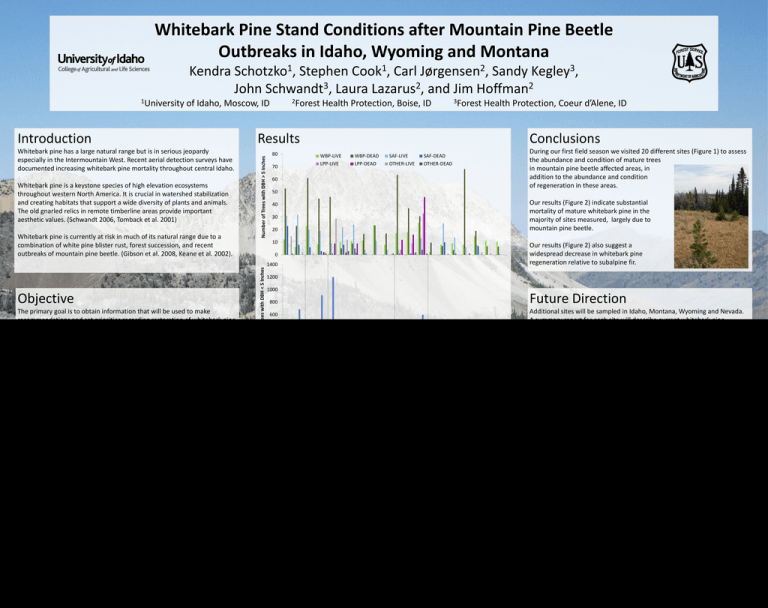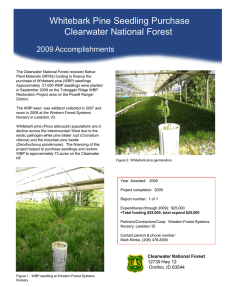Whitebark Pine Stand Conditions after Mountain Pine Beetle
advertisement

Whitebark Pine Stand Conditions after Mountain Pine Beetle Outbreaks in Idaho, Wyoming and Montana Kendra 1University 1 Schotzko , 1 Cook , 2 Jørgensen , Stephen Carl Sandy 3 2 2 John Schwandt , Laura Lazarus , and Jim Hoffman 2Forest of Idaho, Moscow, ID Health Protection, Boise, ID 3Forest Health Protection, Coeur d’Alene, ID Whitebark pine has a large natural range but is in serious jeopardy especially in the Intermountain West. Recent aerial detection surveys have documented increasing whitebark pine mortality throughout central Idaho. Whitebark pine is a keystone species of high elevation ecosystems throughout western North America. It is crucial in watershed stabilization and creating habitats that support a wide diversity of plants and animals. The old gnarled relics in remote timberline areas provide important aesthetic values. (Schwandt 2006, Tomback et al. 2001) Whitebark pine is currently at risk in much of its natural range due to a combination of white pine blister rust, forest succession, and recent outbreaks of mountain pine beetle. (Gibson et al. 2008, Keane et al. 2002). Objective The primary goal is to obtain information that will be used to make recommendations and set priorities regarding restoration of whitebark pine in Central Idaho and adjacent areas in Wyoming and Montana. v Number of Trees with DBH > 5 Inches Results 80 Conclusions WBP-LIVE LPP-LIVE 70 WBP-DEAD LPP-DEAD SAF-LIVE OTHER-LIVE SAF-DEAD OTHER-DEAD 60 50 Our results (Figure 2) indicate substantial mortality of mature whitebark pine in the majority of sites measured, largely due to mountain pine beetle. 40 30 20 Our results (Figure 2) also suggest a widespread decrease in whitebark pine regeneration relative to subalpine fir. 0 1400 1200 1000 Future Direction 800 Additional sites will be sampled in Idaho, Montana, Wyoming and Nevada. A summary report for each site will describe current whitebark pine condition following mountain pine beetle outbreaks as well as condition of other species. 600 400 200 0 Idaho Panhandle NF Helena NF Caribou-Targhee NF & Jedediah Smith Wilderness WBP-Rust WBP-No Rust SalmonChallis NF SAF Sawtooth NF & Sawtooth National Recreation Area LPP OTHER Figure 1. Relative abundance of mature tree species (top graph) and regenerative tree species (bottom graph) at all 20 sites, grouped by geographic area. Species codes: WBP = whitebark pine, SAF = subalpine fir, LPP = lodgepole pine, and Other = all other species. Methods Areas in Central Idaho and adjacent areas in Wyoming and Montana where recent mountain pine beetle outbreaks have occurred were identified from past ADS, local specialists, or other surveys. These areas were sampled using modified FINDITS protocols that use variable radius plots for mature trees and fixed area plots for regeneration. Data collected included: tree species, diameter at breast height, condition. During our first field season we visited 20 different sites (Figure 1) to assess the abundance and condition of mature trees in mountain pine beetle affected areas, in addition to the abundance and condition of regeneration in these areas. 10 Number of Trees with DBH < 5 Inches Introduction This poster focuses on three objectives key to this goal: • Quantify dead and remaining live mature whitebark pine • Assess health of whitebark pine regeneration in these stands • Determine probable stand trajectory by recording abundance of other species 3 Kegley , A B C Figure 2. Number of mature tree species (top row) and regenerative tree species (bottom row) at three representative sites. Species codes as in Figure 1. The numbers next to the regeneration species indicates the size class, where 1 = trees less than 6 inches tall, 2 = trees between 6 inches and 4.5 feet tall, and 3 = trees taller than 4.5 feet with DBH less than 5 inches. Results will be used to make recommendations regarding restoration activities and priorities for restoration. Data will also be used to develop loss prediction models for whitebark pine. Additionally, tests involving reproduction pests will be initiated under laboratory conditions to examine the acceptability and suitability of whitebark pine cones to reproduction pests. WBP-LIVE WBP-DEAD SAF-LIVE SAF-DEAD LPP-LIVE LPP-DEAD OTHER-LIVE OTHER-DEAD Acknowledgements WBP1-Rust WBP2-Rust WBP3-Rust WBP1-No Rust WBP2-No Rust WBP3-No Rust SAF1 SAF2 SAF3 LPP1 LPP2 LPP3 OTHER1 OTHER2 OTHER3 Deb Taylor, Jim Robertson, and the many others at the regional Forest Service offices in the Idaho Panhandle National Forest, Helena National Forest, Salmon-Challis National Forest, Sawtooth National Forest, Sawtooth National Recreation Area, and the CaribouTarghee National Forest. This project was funded by the USDA-Forest Service, Evaluation Monitoring Program. Chad Nelson (Forest Health Protection, Boise, ID), Phil Mocettini (Forest Health Protection, Boise, ID), and Paul Zambino (Forest Health Protection, Coeur d’Alene, ID). William Sweeney and Colleen Makar, University of Idaho, Moscow, ID References Gibson, K.; Skov, K; Kegley, S; Jorgensen, C; Smith, S; and Witcosky, W. 2008. Mountain pine beetle impacts in highelevation five-needle pines: current trends and challenges. USDA Forest Service, Forest Health Protection Report R108-020. Keane, R.E., Ryan, K.C., Veblen, T.T., Allen, C.D., Logan, J.A., and Hawkes, B. 2002. Cascading effects of fire exclusion in Rocky Mountain ecosystems. In: Baron, J.S. (Ed.), Rocky Mountain Futures: An Ecological Perspective. Island Press. Schwandt, J.W. 2006. Whitebark Pine in Peril: A case for restoration. USDA Forest Service, Report R1-0628, Missoula, Montana. Tomback, D.F., Arno, S.F., Keane, R.E. 2001. The compelling case for management intervention. In: Tomback, D.F., Arno, S.F., Keane, R.E. (Eds.), Whitebark Pine Communities: Ecology and Restoration. Island Press.



